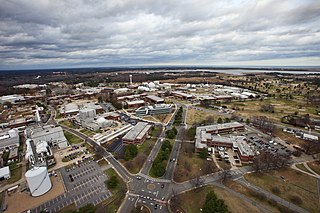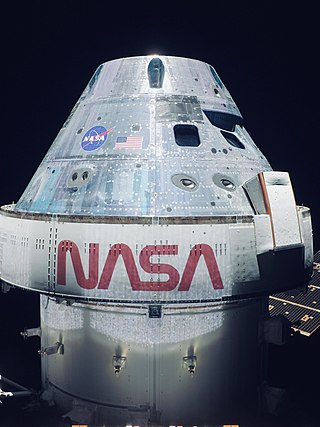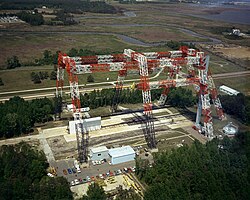
The Apollo program, also known as Project Apollo, was the United States human spaceflight program carried out by NASA, which succeeded in landing the first men on the Moon in 1969, following Project Mercury, which put the first Americans in space. It was conceived in 1960 as a three-person spacecraft during President Dwight D. Eisenhower's administration. Apollo was later dedicated to President John F. Kennedy's national goal for the 1960s of "landing a man on the Moon and returning him safely to the Earth" in an address to Congress on May 25, 1961. It was the third US human spaceflight program to fly, preceded by Project Gemini conceived in 1961 to extend spaceflight capability in support of Apollo.

Apollo 12 was the sixth crewed flight in the United States Apollo program and the second to land on the Moon. It was launched on November 14, 1969, by NASA from the Kennedy Space Center in Florida. Commander Charles "Pete" Conrad and Lunar Module Pilot Alan L. Bean completed just over one day and seven hours of lunar surface activity while Command Module Pilot Richard F. Gordon remained in lunar orbit.

The Apollo Lunar Module, originally designated the Lunar Excursion Module (LEM), was the lunar lander spacecraft that was flown between lunar orbit and the Moon's surface during the United States' Apollo program. It was the first crewed spacecraft to operate exclusively in the airless vacuum of space, and remains the only crewed vehicle to land anywhere beyond Earth.

The Lyndon B. Johnson Space Center (JSC) is NASA's center for human spaceflight in Houston, Texas, where human spaceflight training, research, and flight control are conducted. It was renamed in honor of the late U.S. president and Texas native, Lyndon B. Johnson, by an act of the United States Senate on February 19, 1973.

The Langley Research Center, located in Hampton, Virginia, near the Chesapeake Bay front of Langley Air Force Base, is the oldest of NASA's field centers. LaRC has focused primarily on aeronautical research but has also tested space hardware such as the Apollo Lunar Module. In addition, many of the earliest high-profile space missions were planned and designed on-site. Langley was also considered a potential site for NASA's Manned Spacecraft Center prior to the eventual selection of Houston, Texas.

The Constellation program was a crewed spaceflight program developed by NASA, the space agency of the United States, from 2005 to 2009. The major goals of the program were "completion of the International Space Station" and a "return to the Moon no later than 2020" with a crewed flight to the planet Mars as the ultimate goal. The program's logo reflected the three stages of the program: the Earth (ISS), the Moon, and finally Mars—while the Mars goal also found expression in the name given to the program's booster rockets: Ares. The technological aims of the program included the regaining of significant astronaut experience beyond low Earth orbit and the development of technologies necessary to enable sustained human presence on other planetary bodies.

The Bell Aerosystems Lunar Landing Research Vehicle was a Project Apollo era program to build a simulator for the Moon landings. The LLRVs were used by the FRC, now known as the NASA Armstrong Flight Research Center, at Edwards Air Force Base, California, to study and analyze piloting techniques needed to fly and land the Apollo Lunar Module in the Moon's low gravity environment.

Earth orbit rendezvous (EOR) is a method for conducting round trip human flights to the Moon, involving the use of space rendezvous to assemble, and possibly fuel, components of a translunar vehicle in low Earth orbit. It was considered as an alternative to direct ascent but ultimately rejected in favor of lunar orbit rendezvous (LOR) for NASA's Apollo program of the 1960s and 1970s, mainly because LOR does not require a spacecraft big enough to both make the return trip from Earth orbit to splash down in the ocean, and a soft landing on the lunar surface. The two main proposed methodologies were: the in-space assembly of fueled spacecraft modules via docking techniques; and the in-space refueling of fully assembled spacecraft. This was the preferred approach adopted by the Soviet Union for achieving human lunar missions.

Lunar orbit rendezvous (LOR) is a process for landing humans on the Moon and returning them to Earth. It was utilized for the Apollo program missions in the 1960s and 1970s. In a LOR mission, a main spacecraft and a lunar lander travel to lunar orbit. The lunar lander then independently descends to the surface of the Moon, while the main spacecraft remains in lunar orbit. After completion of the mission there, the lander returns to lunar orbit to rendezvous and re-dock with the main spacecraft, then is discarded after transfer of crew and payload. Only the main spacecraft returns to Earth.

The Kennedy Space Center Visitor Complex is the visitor center at NASA's Kennedy Space Center on Merritt Island, Florida. It features exhibits and displays, historic spacecraft and memorabilia, shows, two IMAX theaters, and a range of bus tours of the spaceport. The "Space Shuttle Atlantis" exhibit contains the Atlantis orbiter and the Shuttle Launch Experience, a simulated ride into space. The center also provides astronaut training experiences, including a multi-axial chair and Mars Base simulator. The visitor complex also has daily presentations from a veteran NASA astronaut. A bus tour, included with admission, encompasses the separate Apollo/Saturn V Center. There were 1.7 million visitors to the visitor complex in 2016.

The Exploration Systems Architecture Study (ESAS) is the official title of a large-scale, system level study released by the National Aeronautics and Space Administration (NASA) in November 2005 of his goal of returning astronauts to the Moon and eventually Mars—known as the Vision for Space Exploration. The Constellation Program was cancelled in 2010 by the Obama Administration and replaced with the Space Launch System, later renamed as the Artemis Program in 2017 under the Trump Administration.

The Crew Exploration Vehicle (CEV) was a component of the U.S. NASA Vision for Space Exploration plan. A competition was held to design a spacecraft that could carry humans to the destinations envisioned by the plan. The winning design was the Orion spacecraft.

Ares I-X was the first-stage prototype and design concept demonstrator of Ares I, a launch system for human spaceflight developed by the National Aeronautics and Space Administration (NASA). Ares I-X was successfully launched on October 28, 2009. The project cost was $445 million. It was the final launch from LC-39B until Artemis 1 13 years later.

The Rendezvous Docking Simulator, also known as the Real-Time Dynamic Simulator, is a simulator at the Langley Research Center. It was constructed for the Gemini program in Building 1244 and it became operational in June 1963 at a cost of $320,000 and later reconfigured for the Apollo program. The simulator consists of a gantry frame, with an overhead carriage from which test craft were suspended by cables. A gimbal was powered hydraulically and was capable of changing pitch and yaw at a rate of 1 radian per second or roll at 2 radians per second. The gantry also moved like an overhead crane using electric motors and was capable of travelling 210 feet (64 m) longitudinally at up to 20 feet per second (6.1 m/s), 16 feet (4.9 m) laterally at up to 4 feet per second (1.2 m/s) and vertically 45 feet (14 m) at up to 10 feet per second (3.0 m/s).

The Virginia Air and Space Science Center is a museum and educational facility in Hampton, Virginia that also serves as the visitors center for NASA's Langley Research Center and Langley Air Force Base. The museum also features an IMAX digital theater and offers summer aeronautic- and space-themed camps for children.

Orion is a partially reusable crewed spacecraft used in NASA's Artemis program. The spacecraft consists of a Crew Module (CM) space capsule designed by Lockheed Martin that is paired with a European Service Module (ESM) manufactured by Airbus Defence and Space. Capable of supporting a crew of four beyond low Earth orbit, Orion can last up to 21 days undocked and up to six months docked. It is equipped with solar panels, an automated docking system, and glass cockpit interfaces. Orion is intended to be launched atop a Space Launch System (SLS) rocket, with a tower launch escape system.
The RS-18 is a reconfigured version of the Rocketdyne Lunar Module Ascent Engine (LMAE), modified to burn liquid oxygen (LOX) and liquid methane (CH4) for NASA's Exploration Systems Architecture Study (ESAS) engine testing in 2008.

The Artemis program is a Moon exploration program led by the United States' National Aeronautics and Space Administration (NASA), formally established in 2017 via Space Policy Directive 1. It is intended to reestablish a human presence on the Moon for the first time since the Apollo 17 mission in 1972. The program's stated long-term goal is to establish a permanent base on the Moon to facilitate human missions to Mars.

The Reduced Gravity Walking Simulator, or Lunar Landing Walking Simulator, was a facility developed by NASA in the early 1960s to study human locomotion under simulated lunar gravity conditions. Located at NASA's Langley Research Center in Virginia, it was designed to prepare astronauts for the Moon landing during the Apollo program.

Project LOLA, or Lunar Orbit and Landing Approach, was a simulator built at the NASA's Langley Research Center to study landing on the lunar surface. Built to aid the Apollo astronauts, it aimed to provide a detailed visual encounter with the Moon's landscape, costing nearly $2 million.


























